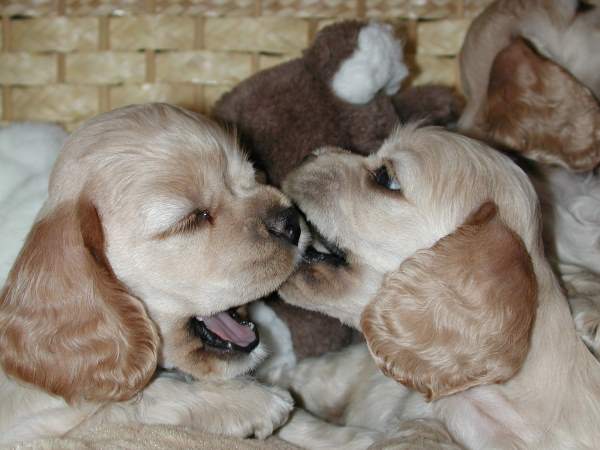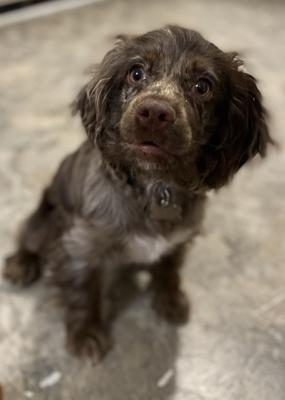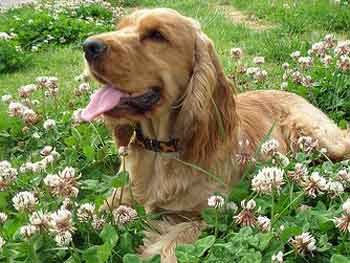- Home
- Getting A New Puppy
- Bringing home a new puppy
Bringing Home A New Puppy? Here's All You Need To Help You Care For Him!
Bringing home a new puppy is such an exciting time, so it's easy to overlook essential preparations during all that excitement!
You can take some steps to help your puppy settle into his new home quickly, comfortably and without fuss, making his life and yours much easier! Learn how to prepare for your new puppy's arrival and discover practical tips and advice to help your Cocker Spaniel feel at home.
Bringing Your New Puppy Home Is So Exciting! Here's How To Prepare
Here are a few links to each section, briefly explaining what's covered. Enjoy!
- Collecting your puppy: You can do many things to help make your puppy's departure and journey to his new home more comfortable.
- Arriving home with your new puppy: What happens next? For starters, introduce him to his new family and his new home.
- Your puppy's first night: Bringing home a new puppy and expecting him not to cry during his first night is a big expectation. Learn how to help your new baby get through his first night in this strange new place away from his mother and siblings.
- Your puppy's ongoing care routine: Learn to care for your new puppy's daily needs.
If you've not yet brought your tiny fur bundle home, here are some things you can do in preparation for the big day!
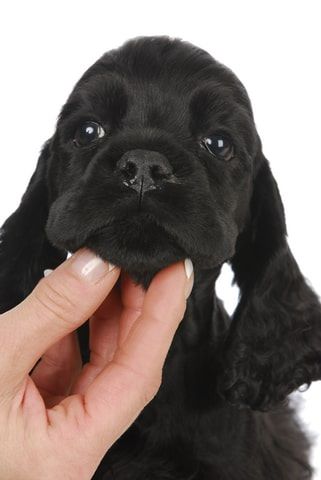 What a sweet little boy!
What a sweet little boy!Bringing Home A New Puppy: Essential Preparations To Help You Get It Right!
Preparing for bringing your new puppy home is essential to help your new puppy settle in and manage without his mother and littermates.
No matter how hard you try, a couple of last-minute things will always be forgotten in the excitement of bringing a new puppy home.
- If you haven't already done so, you'll need to make sure your home and garden are puppy-proof.
- By now, you should have the basic essential supplies to get you through the first couple of weeks.
- About a week before you collect your Cocker pup, leaving a worn, smelly tee-shirt with the breeder is a great idea. (Wear it in bed for a few nights, but don't wash it. The breeder can give it to your puppy to sleep on, which will help your new pup get used to your scent.)
- You could also leave a blanket and a soft toy with your breeder so it can be placed in the whelping box.
When it's time to collect and bring your puppy home, your 'smelly' tee-shirt, the blanket, and the toy will have his mother's and his litter-mates scent on them.
This will help your Cocker Spaniel puppy feel more comfortable and secure in his new strange human world.
Collecting Your New Little Puppy By Car? Top Tips To Make It Stress-Free!
It's so exciting that you're bringing home a new puppy, and the day has finally arrived to collect him from the breeders!
It would help to consider how you will get him to his new home.
If you're going by car, which is more likely, ask someone to drive you. If your pup becomes restless or anxious, you can take care of him without worrying about controlling the car.
If you're on your own, take a dog crate, a pet carrier, or even a cardboard box with ventilation holes punched into the lid to ensure your new puppy isn't loose in the car.
Getting your puppy to his new home, safe, sound, and without trauma, will be your overriding aim here. Here are a few tips to help you achieve that.
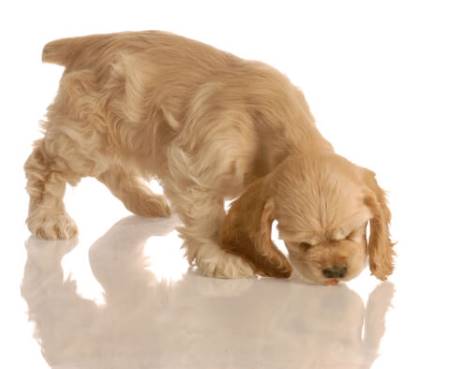 Oh, look what I've found!
Oh, look what I've found!- Your puppy will almost certainly need to pee (and maybe even poop) on the way home. Layer the carrier with plenty of old newspaper; that way, you won't need to worry if you've a long drive in front of you.
- Take a roll of kitchen towel with you, a plastic bag and perhaps some wet wipes, just in case your new puppy gets car sick and you need to clean up.
- If you're bringing home a new puppy on a sweltering day, take a bottle of water and a small bowl to give him a drink if he gets thirsty.
- If it becomes too hot for your puppy, you may need to create some shade from the sun whilst he's in the car.
- If it's a cold wintry day, you can wrap him up in his new 'scented' blanket. It will keep him warm, toasty, and much more comfortable.
- When bringing home a dog or a new puppy in a car, never be tempted to stop at the side of the road to let him out to pee. I've heard of puppies being killed in similar situations after darting into the middle of a busy road!
It doesn't bear thinking about, does it? But fatal accidents happen all too easily and all too quickly! They don't know any different at this young age and they certainly don't understand that fast moving cars can be dangerous!
Personally, I'd keep him inside and wouldn't take any risks. Let him pee on you if he has to; he's just too precious!
Bringing Your New Puppy Home: It's So Exciting!
I think you'll agree that this video from Syndia Art sums up the excitement of bringing home a new puppy, a golden Cocker Spaniel. He's absolutely beautiful, and I feel her excitement! I hope you enjoy it!
You've Arrived Home Safely With Your New Puppy! What Next?
At last, you've arrived home with your cute little ball of fur, and now all you want to do is cuddle, stroke, play and generally make a fuss of him.
There's nothing wrong with that, but there are a couple of things I recommend you do first!
Take Your Puppy for a Pee Break In The Garden
If you don't want your new puppy to pee in the house as soon as you get him through the door, take him into the garden.
Take him to the spot you've chosen for him to do his toilet, and let him wander around for a little while to see if he wants to pee, but don't leave him alone.
Introduce Your Puppy To His New Family and Home!
After a few minutes, regardless of whether he's peed or not, take him inside, and introduce him to his new family.
Show him his sleeping area, and give him a few minutes to explore it. (I'm hoping you've chosen to use a crate for his bed - I recommend it!).
Next, take him to his feeding area and show him his food bowl (with a morsel of food) and his water bowl, filled to the brim with fresh cold water. He may be thirsty and need a drink after his journey.
If he eats anything or takes a drink, you may need to take him outside again. Yes, you'll be doing a lot of that until he's fully potty trained!
Kids Overwhelming Your Little Puppy? Read The Riot Act to the Kids!
If you have children, be sure you've read them the riot act and that they know how to behave around their new puppy.
When the pup is around, they must remain calm and reasonably quiet, making no sudden moves that could frighten him.
Give Your Loveable New Puppy Some Quiet Time To Help Him Settle In
Next, take your new pet to a room where you can sit, relax, and spend a few quiet minutes together, without any distractions; this is great bonding time.
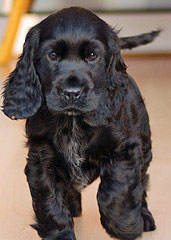 Hello Mum!
Hello Mum!His New Home Will Seem Alien: Watch Your Cute Little Puppy Closely!
Your puppy may be quite lively if he's slept during the journey, so let him explore.
Watch your puppy like a hawk, especially if he didn't pee in the garden, because it's likely he still needs to be fully potty trained!
If he's tired, let him fall asleep, gently place him in his new crate and leave him.
As soon as he wakes, take him outside again to see if he wants to pee, then bring him inside and offer him some food.
Bringing a puppy home may be exciting for you and your family, but it can be quite an upsetting and anxious time for a tiny pup. Everything will be strange to him, so don't be surprised if he doesn't eat; he may need time to adjust to his new surroundings and family.
He'll also miss his mother and siblings' familiar, comforting smell. However, the scent from his blanket (which you left in the whelping box, now in his crate) should help him feel a little easier.
Important Note: If your pup fails to eat over the next few days, is sick, has prolonged diarrhoea, or generally seems unwell, don't hesitate to contact your vet; the sooner, the better. Your vet won't mind if it's a false alarm. It's better to be safe than sorry!
Tips To Help Your New Puppy Get Through His First Night Home
Your puppy will almost certainly cry during his first night because he'll miss the warmth and comfort of his mother and litter-mates. This can be heart-breaking, especially if you don't know what to do for the best.
What follows is a suggested new puppy care routine to help get him through his first night in his new home without too much trauma.
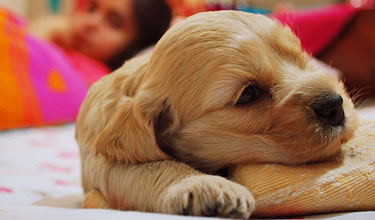 I'm tired, Mum!
I'm tired, Mum!- Offer your puppy a little food and water two or three hours before you plan to put him to bed for the night.
- Remember to take him to his designated toilet area to see if he wants to pee. Stay with him for a few minutes, bring him back inside, and let him settle for a while.
- Let him have a little playtime before his bedtime. The mental and physical stimulation will help tire him out and help him sleep more soundly during his first night.
- Before you put him to bed, take him out for another pee...you'll be doing this a lot until he's fully house-trained!
- Bring him back inside and give him a cuddle to help him wind down and relax. He may fall asleep on your lap (after all, he'll have had a busy, if not traumatic, day!).
- Once he's sleeping, gently place him in his crate for the night, along with the 'scented' soft toy and blanket.
- If he doesn't fall asleep, try placing him in his crate anyway. With a bit of luck, he'll play quietly or snuggle up to his soft toy before nodding off.
- If your puppy cries when left alone, I recommend you ignore him and leave him where he is. Although it will be heart-breaking to hear, it will be better in the long run if you leave him. He will get over this, I promise.
 There's lots of room in this bed, Mum
There's lots of room in this bed, Mum- However, if you can't bear to leave him, or if he becomes too distressed, then you might want to bring him into your bedroom to sleep (but in his own bed or crate) and move him back into his proper sleeping place when he's settled down, or fallen asleep.
- Some Cocker owners swear by placing a ticking clock by the crate for the first few nights; the ticking sound is said to replicate the mother's heartbeat and has helped soothe many unsettled puppies.
A word of warning, though, please remember to switch off the alarm!
If your puppy continues to cry for the next couple of nights and you know he's warm and comfortable, not ill or in pain, you'll need to stand firm and leave him where he is; otherwise, he'll learn that when he cries, you'll always come to him.
Believe me, just like with babies, that's a recipe for disaster!
When you go to your puppy in the morning, don't be surprised if he's messed in his crate overnight, it's perfectly natural. Don't scold him or make a fuss; simply clean it up and get on with the day.
If he's still asleep or has just woken, take him straight outside before he has the opportunity to have any minor 'accidents'.
Bringing Home A New Puppy: Your Fur Baby's Ongoing Care
These tips about bringing home a new puppy will help to make you feel more confident
and help you to get him safely through his first night
in his strange new world.
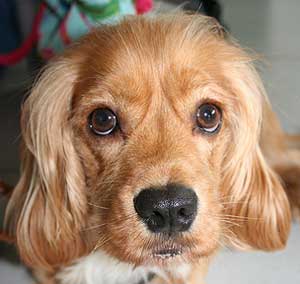 Please, Mum?
Please, Mum?But this is only just the beginning; the real work starts now!
Just like babies, puppies thrive on a routine, so I recommend carefully considering what that routine should be before bringing home a new puppy.
He will do a lot of sleeping, exploring, playing, eating and drinking (followed by peeing and pooping).
He must be toilet trained, groomed, exercised, obedience trained, and adequately socialized to help him grow up happy and confident about his environment.
This ultimate guide to Cocker Spaniel puppy care will help you with all this and more.
I recommend you begin a daily routine for your puppy from his first day in his new home and stick to it.
Good luck!
Photo credits: Bringing Home a New Puppy
1. Willeecole at https://www.dreamstime.com/stock-image-cocker-spaniel-puppy-image16929421
2. Willeecole at https://www.dreamstime.com/stock-image-puppy-chasing-piece-dog-food-image7324311
3. Ken Moffat - https://www.flickr.com/photos/14438577@N06/1479395874/in/dateposted/
4. Jaskirat Singh Bawa at https://www.flickr.com/photos/jzsinr/3385526210/in/dateposted/
5. Cynoclub at https://www.istockphoto.com/stock-photo-10051067-cute-puppy.php
6. Herr Bert at Flickr.com
